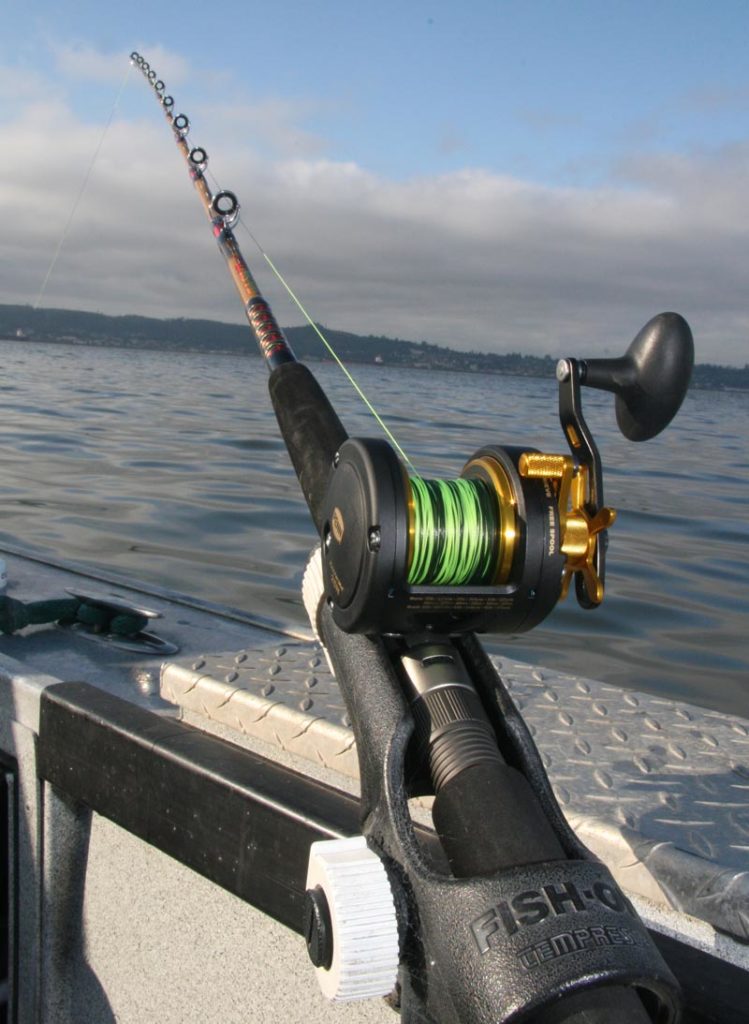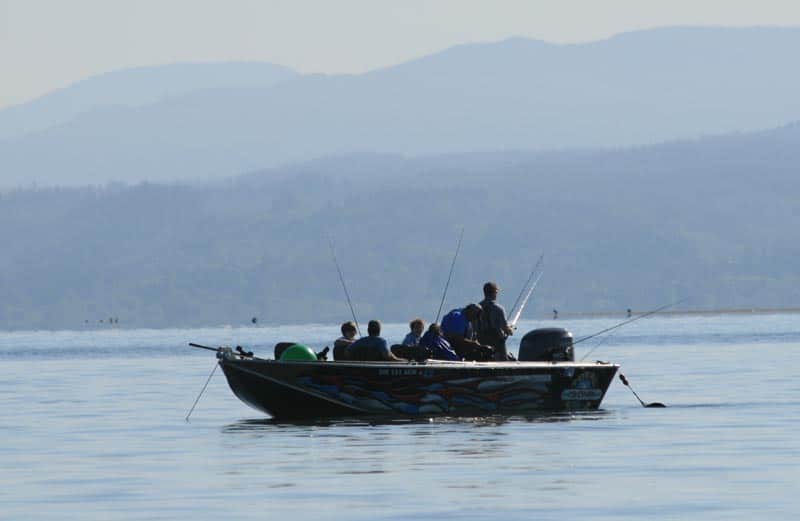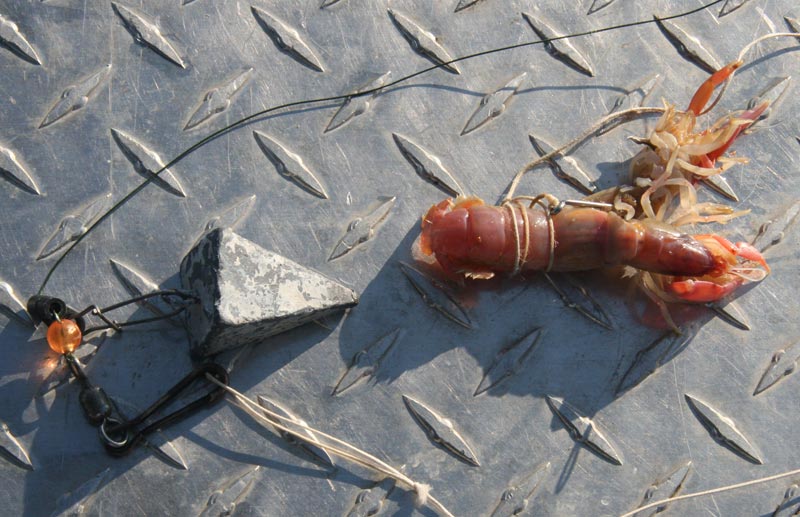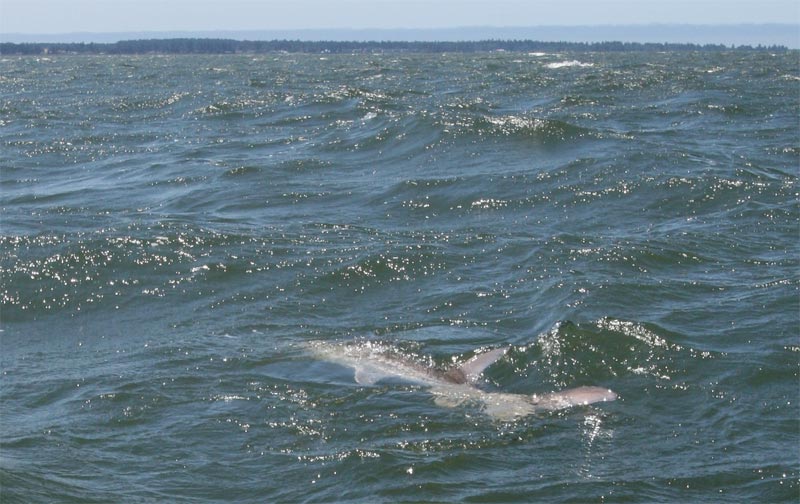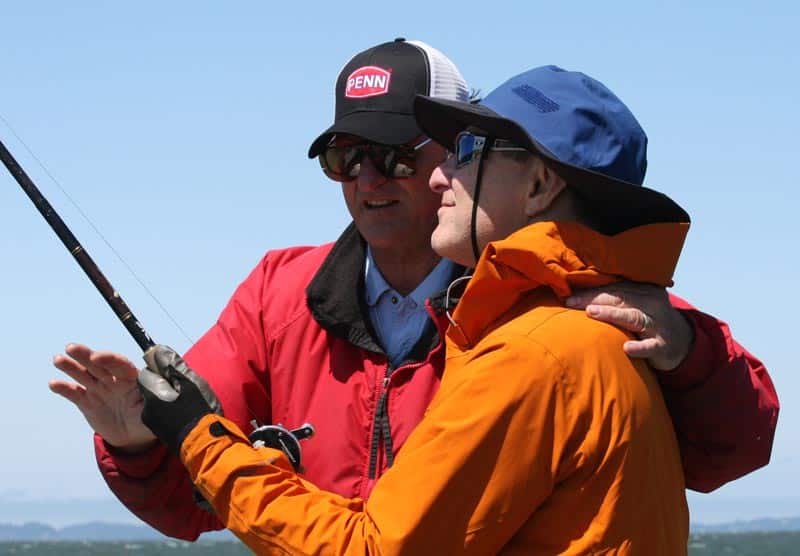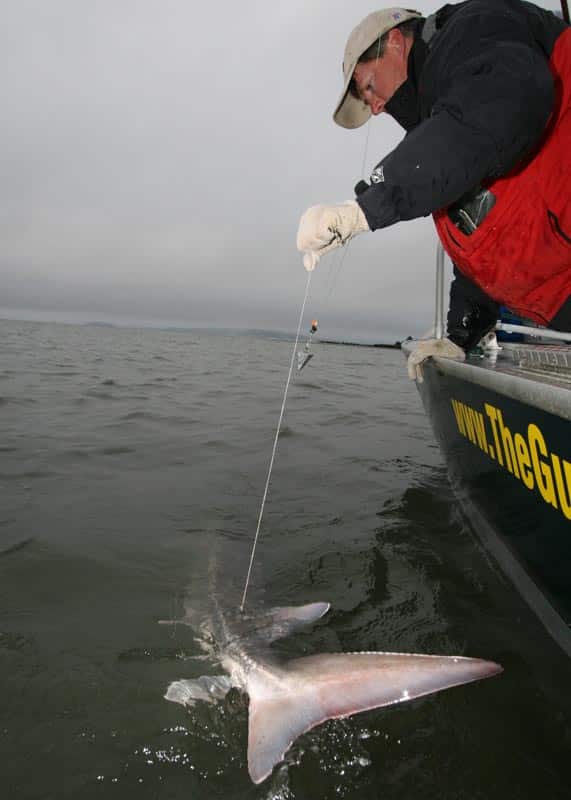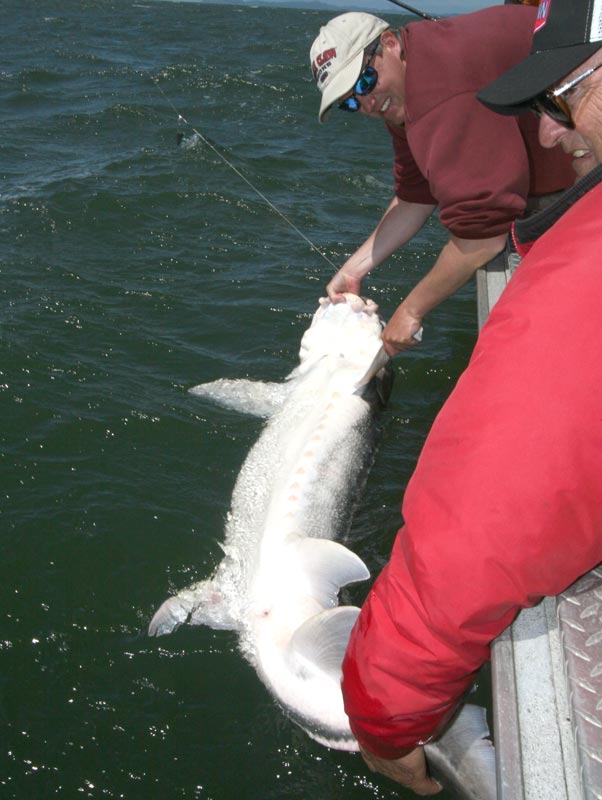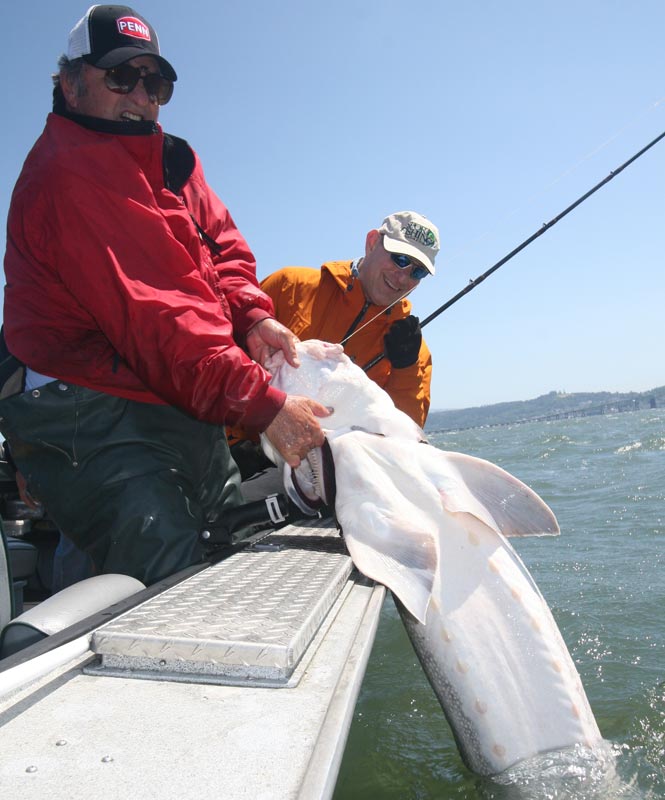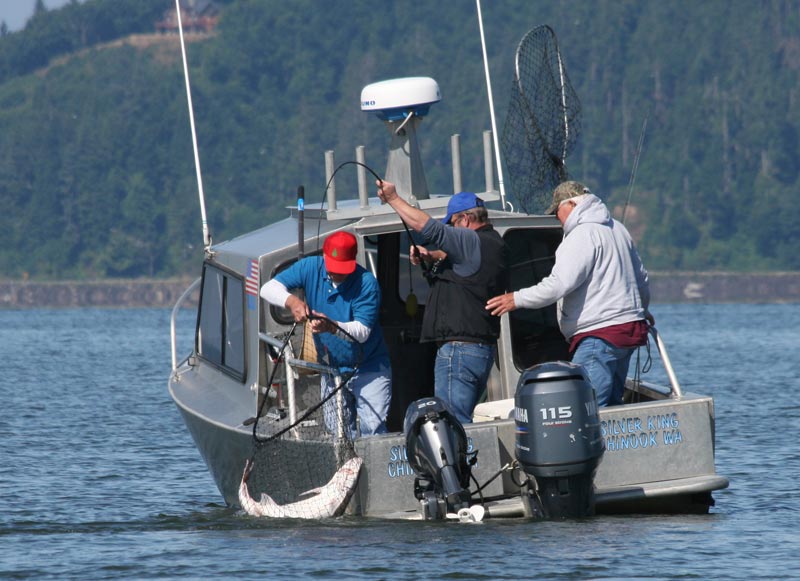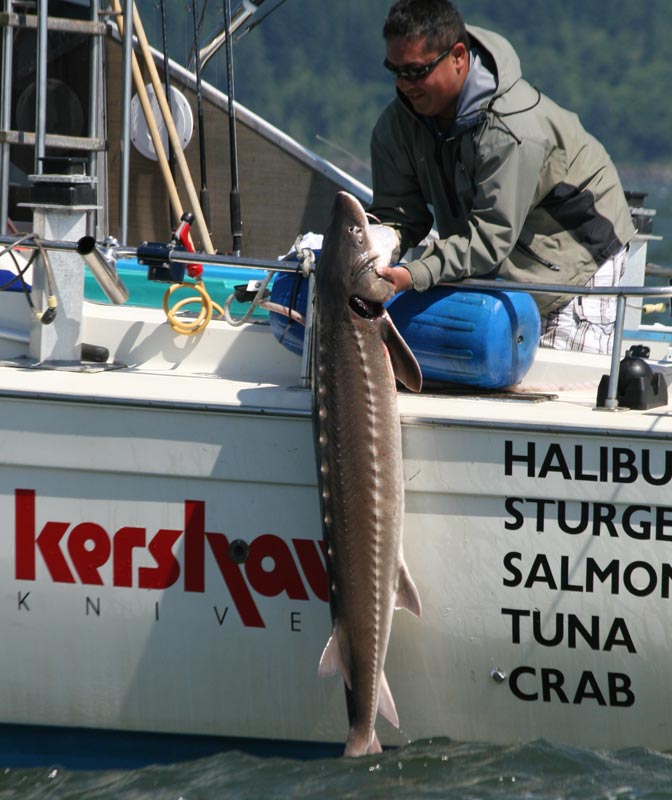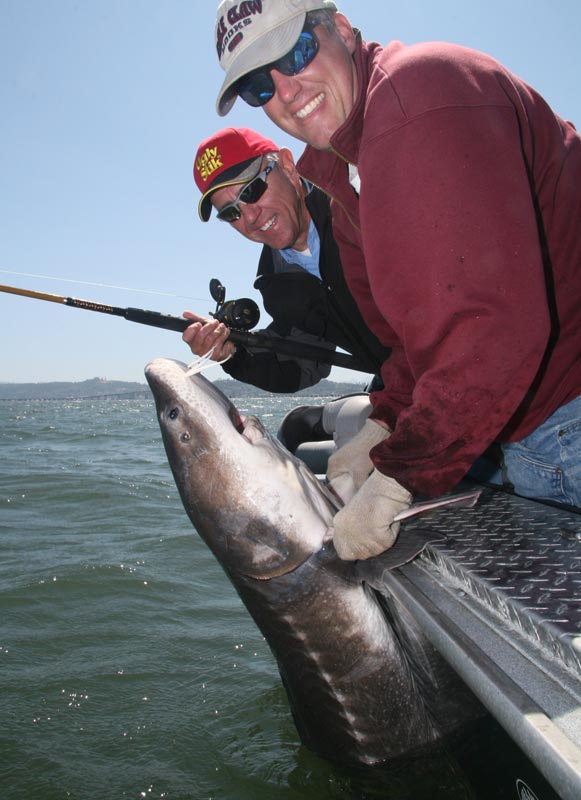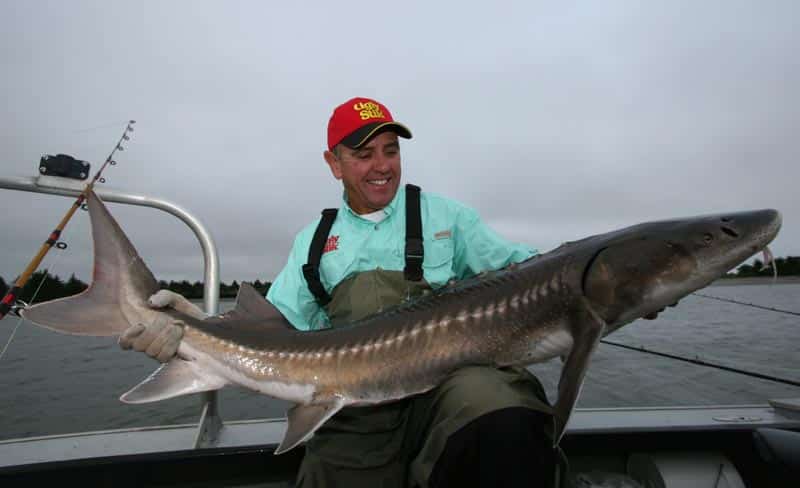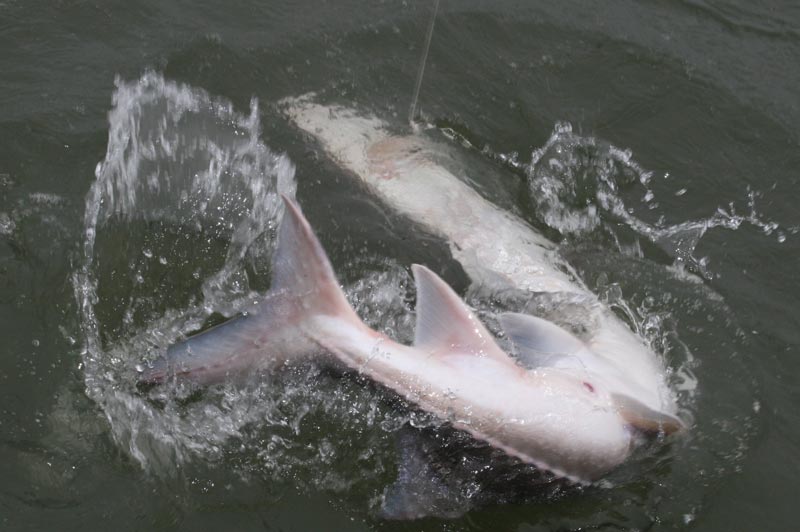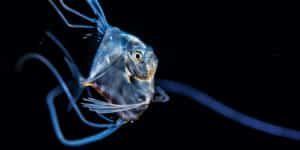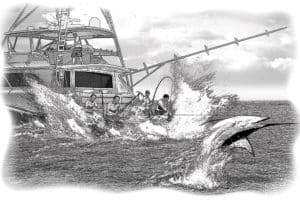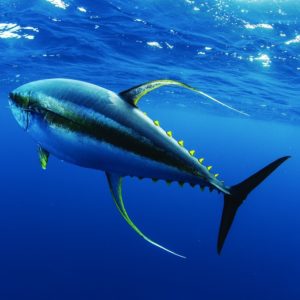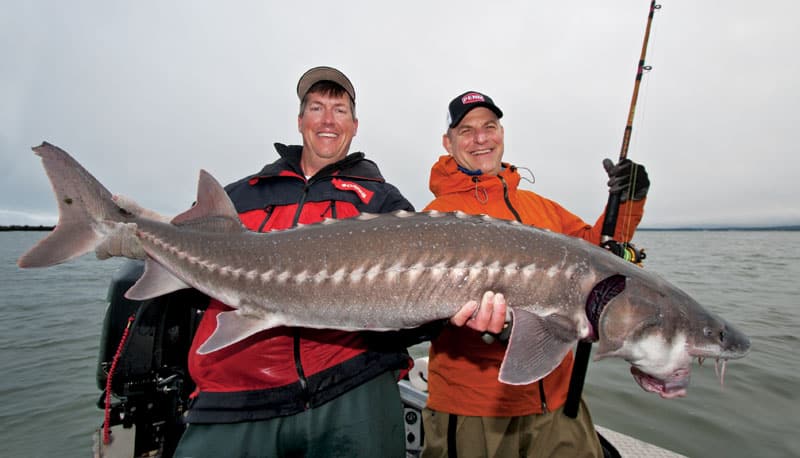
They’ve been known to jump into boats out here. In fact, I hooked a big one a while back, and immediately it jumped right next to the boat, crashing into the gunwale. I stiff-armed it with both hands and just managed to keep it from landing in the boat. If it had, we’d have been in real trouble, since it had to weigh around 300 pounds.”
The words of Jim Martin, of Mulino, Oregon, could be describing the behavior of that king of jumping game fish, the tarpon. That he is actually describing a sturgeon — a fish as dissimilar to tarpon as you might imagine — would come as a shock to anglers unfamiliar with the species (and that would be most anglers).
After all, unlike tarpon, sturgeon spend their time foraging for food by sucking up tidbits from muddy bottoms with their soft, tubular, underslung mouths, sensing the good stuff with a set of barbels like those on an old “bearded” black drum. Rather than shiny silver scales, they’re encased in a tough, armorlike skin of ancient design.
Does that sound like a fish that would jump?
White Sturgeon Can Jump
Take it from me, sturgeon jump. And jump and jump.
I fished the Columbia River mouth with Martin — years ago, the head of Oregon’s Fisheries Division of the Department of Fish and Wildlife, and these days, director of the Berkley Conservation Institute — and, barely inside the edge of the open Pacific, I saw sturgeon after sturgeon free jumping above the river, near and far, and others rolling (again, rather as tarpon do). Judging size wasn’t easy, but a lot of these armored missiles were clearly into triple digits, so we’re not talking small fish.
But that was hardly the only surprising thing about the species and about fishing for it. The Columbia is a huge, deep powerful river. Sturgeon often forage in very deep water. But not necessarily here.
Our skipper, Bob Rees, had anchored up his 25-foot Alumaweld jet sled in about four feet of water. We were fishing practically on the flats.
In fact, says Martin: “I’ve seen times when the tide is way out, and sturgeon will be in shallow channels between sandbars where you can see them tailing. And they’re feeding!”
But when it comes to rigging up, all similarities with tarpon fishing ends. No fluoro leaders here: Rees ties his 50- to 65-pound Fireline main line to a leader of slightly heavier braid. That makes sense when one realizes that sturgeon feed not by sight but by feel, and thin, soft, hairlike braid has a much less distinct, artificial feel than stiff, thick fluoro or mono. A 4- to 10-ounce pyramid sinker is needed to keep the bait (most often sand shrimp or anchovy) on bottom, but it hangs from a plastic slider to minimize any resistance felt by the sturgeon’s sensitive mouth.
Soon four anglers — Martin; Paul Sherman, from Anacortes, Washington; Pure Fishing’s Hunter Cole; and me — each tended a rod. We didn’t have to wait long. After a couple of missed bites (huge sturgeon can be notoriously delicate), Cole felt the bite, swung and connected.
Whether a sturgeon is 50 pounds or 250 might not be immediately obvious. This one did jump near the boat, and it appeared to be around the upper reaches of the legal 41- to 54-inch slot. I hunkered down a bit, recalling how just a month earlier near my home base in Florida, two people had been seriously injured in separate incidents by sturgeon leaping into their boats in the Suwannee River.
But this fish tried to make like a permit and charged off away from the boat before it jumped again. A 60-pound fish in four feet of water can go only two ways: up and out. Cole’s fish did both until he finally brought it boat-side — after discovering how tough sturgeon are, with repeated runs and an obvious reluctance to give it up — for some quick release photos.
**
An Overlooked Catch-and-Release Fishery**
The recreational-fishing season when sturgeon may be kept in the lower Columbia varies from year to year. The season this year will be shorter than in 2011. After some recent years of great abundance with some astounding fishing (“We’ve had days where five anglers literally stopped counting after releasing 70 sturgeon,” Rees says, recalling the 20- to 50-pound average), a decline in sturgeon numbers means a quota reduced 38 percent to 9,600 fish in total.
In the area of the Columbia River mouth where we fished, the season was open through April 30, closed May 1 to 11, and remains open May 12 through July 8, with a bag limit of one fish having a fork length of 41 to 54 inches.
The big mistake many anglers make is they stop fishing when the season closes, says Martin. Whether they switch their attentions to salmon or simply stop fishing for sturgeon, the bottom line is: “This fishery is a blast!” he says. “It offers tremendous catch-and-release sport.”
So during July (after the 8th) and again in September (typically the water temperature becomes too warm for the fish to feed actively in August), a few smart private-boat anglers and a few guides, like Rees, will pretty much have the fishery and the fast action it offers to themselves. (By October, the water’s becoming too cold for the sturgeon’s liking until they return in the spring; Martin says most overwinter farther upriver.)
Rees acknowledges that those 70-fish days “with triples and quads all day long” have been rare in recent years. “These days, a good day is 20 to 25 fish,” which by most standards is still pretty impressive.
“The sturgeon population here is nowhere near whatever it was in its peak years,” Martin agrees, “but it’s probably the healthiest sturgeon stock in the world.”
That’s no accident. Martin says Columbia River sturgeon, shared by Oregon and Washington, is a very tightly and very effectively managed fishery. The quota allocations for commercial (80 percent) and recreational (20 percent) fishermen ultimately determine seasons, which are thus subject to change.
**
1,800-Pound Sturgeon**
This fishery is really about one species of sturgeon, the white (Acipenser transmontanus). And if you suspect talk of 300-plus-pound fish measuring 8 feet long is hyperbole, you’re wrong. In fact, that’s a mere pup.
The IGFA all-tackle world record weighed in at 468 pounds. That fish was taken in San Pablo Bay (northern reaches of San Francisco Bay) in 1983. Are there white sturgeon in the bay more than 500 pounds? Probably, but the all-tackle record remains safe. In 1983, no maximum-size limit precluded weighing such behemoths; these days, they’re strictly released boat-side. (California’s slot limit is only slightly larger than Oregon’s, at 46 to 66 inches.)
But then 500 pounds isn’t all that big, really — not when compared with some taken commercially in the 1800s that were at least 1,500 and might have been as much as 1,800 pounds.
Whites range from central California north into British Columbia. Anadromous, they spend much of their lives nearshore in the Pacific, but enter larger estuaries to ascend far up rivers to spawn. (Those above Bonneville Dam on the Columbia are trapped there; they thrive but grow more slowly in the less-productive fresh water.)
Although the growing demand for caviar led to the demise of white sturgeon populations in the late 19th century, hydroelectric dams later provided a double whammy. Careful management in the past 50 or so years has strengthened populations.
The other species of sturgeon that frequents many of the same waters as whites is the smaller green sturgeon (A. medirostris). Greens are neither as tasty as whites, which are generally considered delicious, nor as likely to be caught. Although Rees isn’t sure why that is, he speculates that greens (a more saltwater-oriented fish) don’t feed as heavily in the lower river, though their abundance is evidenced by large numbers that turn up in gill nets at times.
Current Events
When it comes to tackle selection for sturgeon, you probably won’t see spinning gear except among some die-hards from distant areas. Levelwinds are pretty universal, offering great sensitivity and near-zero reaction time. Rees favored Penn Fathom star-drag reels on our outing. He has stuck with J hooks, explaining that even though we missed a number of fish, typically his hookup rates are good and rarely are sturgeon deeply hooked.
On the other hand, sturgeon guide Kevin Newell (Total Fisherman Guide Service), prefers circles. An oversize circle hook works best. He prefers to go larger than one would typically expect: The larger gap seems to dig in better, and a heavier size is less likely to straighten under the strain of a 200-plus pounder.
While summer days might be warmer and dryer than most of the year, wind can still be a real nuisance. Often, it will be calm and foggy early, but by afternoon, a stiff northwestern breeze springs up over the river.
Getting a break from the wind is a big help, but there’s also current to consider. Rees says sturgeon bite best on an incoming tide. But whatever the direction, he says, tidal movement is important. Except during slack tides, the default situation on the Columbia is current, and lots of it. Sturgeon boats anchor, sometimes using two hooks, to allow baits to remain relatively stationary on the bottom.
That’s important on shallow midriver banks, over which currents sweep as water rushes in and out of the river mouth at up to 3 knots. We fished some popular sturgeon banks, including one known as Taylor Sands, north of the Megler-Astoria Bridge, and Desdemona Sands, south of the Bridge.
We caught fish and had action both days we fished. The second day gave us a taste of Columbia River mouth sturgeon fishing when it’s on, allowing us to put a couple of fish in the boat, and releasing (and losing) quite a few more in the course of a morning.
The one word that kept coming to my mind on that last calm, misty morning was “surprising.” So many things about this quintessentially Pacific Northwest fish would surprise most anglers — sturgeon that can leap like tarpon and run like permit, often feed in water just waist deep, and offer fantastic catch-and-release sport, where the Columbia meets the Pacific.
TRIP PLANNER
Contacts
Capt. Bob Rees — www.northwestguides.com, 503-812-9036.
There are a number of guides who fish sturgeon based both in northern Oregon and southern Washington, as well as larger charters (in fact, small open-party head boats) based in Astoria, Oregon, and Ilwaco, Washington.
Beach House Vacation Rentals in Seaside — www.beachhouse1.com, 800-995-2796. We enjoyed Seaside, a short drive south of the river, and prefer staying in a house like those managed by Beachhouse Vacation Rentals. You’ll find no shortage of hotels, condos and B&Bs from Seaside to Astoria.
Oregon Coast Visitors Association — visit www.theoregoncoast.com.
To get more info on any/all aspects of visiting the area, visit this site.
Options
Spring and summer are also great times to fish salmon and, later, steelhead. The lower Columbia sees excellent runs of chinook and, in August, coho. At times, the best salmon fishing will be inside the river bar; at other times, it will be out on the ocean. Starting in mid-July, albacore runs might show offshore within range of larger sport-fishing boats.
Suggestions
Bring plenty of warm clothing and good foul-weather gear. Even in midsummer, mornings are often gray, damp and cool. And even when the sun shines, the northwest breeze can make it very chilly on the water. You can always take it off, but you can never put on what you didn’t bring. Rubber deck boots are great, though you can get by without them. A camera is a no-brainer.

